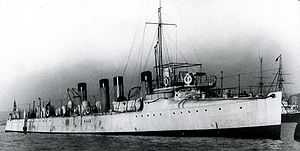Shirakumo-class destroyer
 Japanese destroyer Shirakumo during commissioning, England, 1902 | |
| Class overview | |
|---|---|
| Builders: | John I. Thornycroft & Company Chiswick, England |
| Operators: |
|
| Preceded by: | Akatsuki class |
| Succeeded by: | Harusame class |
| In commission: | 1902-02-13 – 1923-04-01 |
| Completed: | 2 |
| Active: | 0 |
| Lost: | 0 |
| Retired: | 2 |
| General characteristics | |
| Type: | Destroyer |
| Displacement: | 322 tons normal, 428 tons full load |
| Length: | 65.89 meters pp, 67.51 meters overall |
| Beam: | 6.34 meters |
| Draught: | 1.89 meters |
| Propulsion: | 2-shaft reciprocating engines, 4 boilers, engine output 7,000 hp (5,200 kW) |
| Speed: | 31 knots (57 km/h) |
| Complement: | 62 |
| Armament: |
|
The Shirakumo-class destroyers (白雲型駆逐艦 Shirakumogata kuchikukan) was a class of two torpedo boat destroyers (TBDs) of the Imperial Japanese Navy.[1]
Background
The Shirakumo-class destroyers were ordered under the 1900 fiscal budget as a follow-on to the earlier Murakumo-class. Both were ordered from the yard of John I. Thornycroft & Company in Chiswick, England.[2] These were amongst the last destroyers purchased by Japan overseas; most subsequent destroyers in the Imperial Japanese Navy were either prizes of war, or were built in Japan.[3]
Design
Substantially identical to the previous Murakumo-class, the Shirakumo-class was slightly larger in displacement with a slightly more powerful engine. The main difference externally between the vessels was in the design of their rudders. With the previous class, the rudder was semi-balanced, and had a portion exposed above the waterline. This made the vessel vulnerable to disablement by stray gunfire.
The design of the Shirakumo-class destroyers was similar to that of the two-stack torpedo boat destroyers produced by Thornycroft for the Royal Navy; (from 1913 these were grouped as the D class), also known as the “Thirty Knotters”. Both vessels had a flush deck design with a distinctive "turtleback" forecastle that was intended to clear water from the bow during high speed navigation, but was poorly designed for high waves or bad weather. The bridge and forward gun platform were barely raised above the bow, resulting in a wet conning position. More than half of the small hull was occupied by the boilers and the engine room. With fuel and weaponry, there was little space left for crew quarters.
All were powered by triple expansion steam engines for 7,000 shp (5,200 kW) and had coal-fired water-tube boilers. Armament was one QF 12 pounder 12 cwt gun on a bandstand on the forecastle, five QF 6 pounder Hotchkiss (two sited abreast the conning tower, two sited between the funnels and one on the quarterdeck) and 2 single tubes for 18-inch (460 mm) torpedoes.[4]
Operational history
Both Shirakumo-class destroyers arrived in Japan in time to be used in combat service during the Russo-Japanese War of 1904–1905 and were assigned to the 4th Destroyer Squadron under Admiral Dewa Shigeto. Both played an especially distinguished role in the crucial Battle of Tsushima.[5]
On 1912-08-28, both vessels were re-classified as third-class destroyers and were removed from front line combat service. They were converted to auxiliary minesweepers on 1922-04-01, but were used for only a year until converted to unarmed utility vessels.[6]
Ships
| Kanji | Name | Builder | Laid down | Launched | Completed | Fate |
|---|---|---|---|---|---|---|
| 白雲 | Shirakumo | Thornycroft, Chiswick, UK | 1901-02-01 | 1901-10-01 | 1902-02-13 | aux minesweeper 1922-04-01; utility vessel 1923-04-01; sold 1925-07-21 |
| 朝潮 | Asashio | Thornycroft, Chiswick, UK | 1901-04-03 | 1902-01-10 | 1902-05-04 | aux minesweeper 1922-04-01, utility vessel 1923-04-01; sold 1926-04-05 |
See also
![]() Media related to Shirakumo class destroyer at Wikimedia Commons
Media related to Shirakumo class destroyer at Wikimedia Commons
Notes
References
- Evans, David (1979). Kaigun: Strategy, Tactics, and Technology in the Imperial Japanese Navy, 1887–1941. US Naval Institute Press. ISBN 0-87021-192-7.
- Howarth, Stephen (1983). The Fighting Ships of the Rising Sun: The Drama of the Imperial Japanese Navy, 1895–1945. Atheneum. ISBN 0-689-11402-8.
- Jane, Fred T (1904). The Imperial Japanese Navy. Thacker, Spink & Co. ASIN: B00085LCZ4.
- Jentsura, Hansgeorg (1976). Warships of the Imperial Japanese Navy, 1869–1945. US Naval Institute Press. ISBN 0-87021-893-X.
- Lyon, David (2006). The First Destroyers. Mercury Books. ISBN 1-84560-010-X.
- Cocker, Maurice (1983). Destroyers of the Royal Navy, 1893–1981. Ian Allan. ISBN 0-7110-1075-7.
External links
- Nishida, Hiroshi. "Materials of IJN: Shirakumo class destroyer". Imperial Japanese Navy.
| ||||||||||||||
| ||||||||||||||||||||||||||||||||||
| ||||||||||||||||||||||||||||||||||||||||||